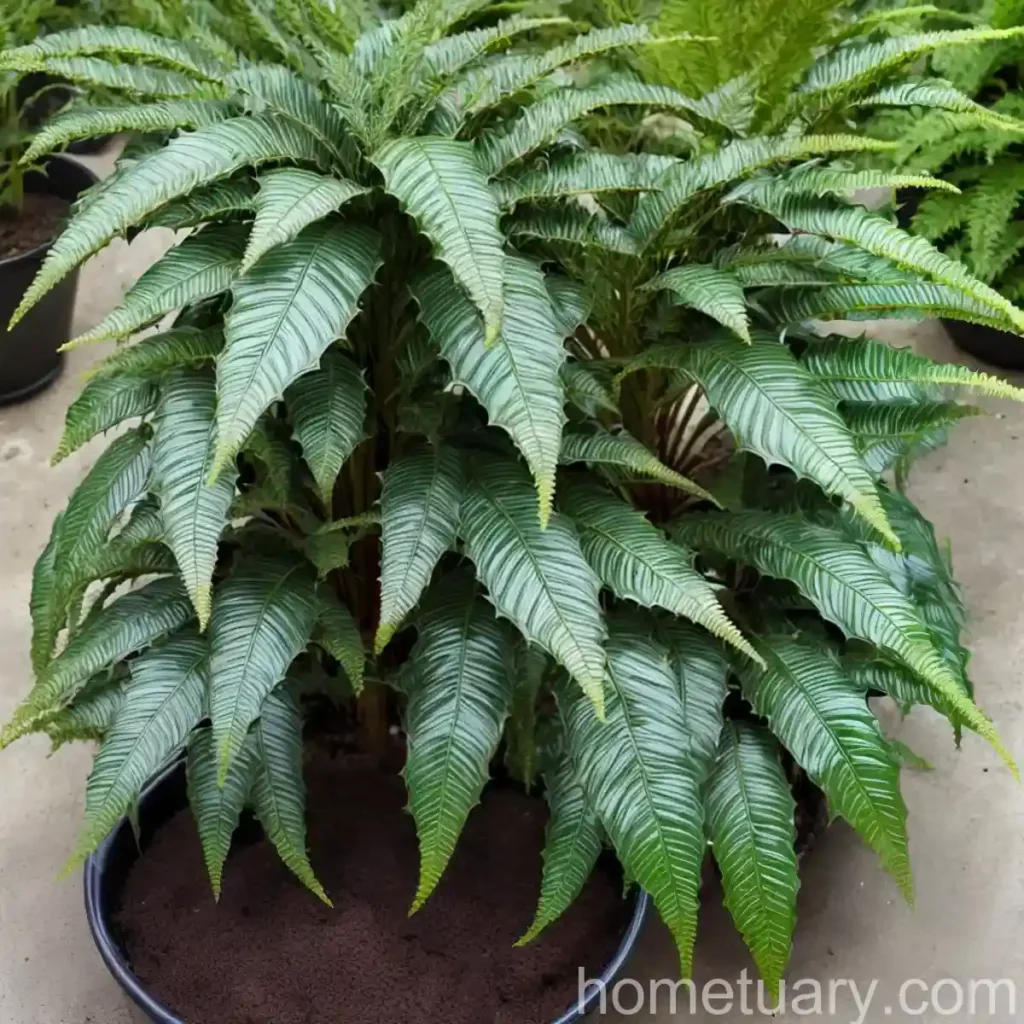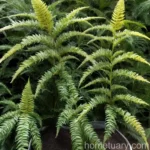Japanese Holly Fern (Cyrtomium fortunei var. clivicolum) Care Guide
What is Plant: Japanese Holly Fern (Cyrtomium fortunei var. clivicolum)
Japanese holly fern, scientifically known as Cyrtomium fortunei var. clivicolum, is a delightful evergreen fern popular for its glossy and textured fronds. This fern variety is native to Japan, where it thrives in the shaded understory of forests. It belongs to the Woodsiaceae family and is a classic choice for gardens, landscapes, and indoor spaces.
Key Takeaways – Japanese Holly Fern (Cyrtomium fortunei var. clivicolum)
- Japanese holly fern care: Thrives in shady spots, requires consistent moisture, and suitable for various containers and gardens.
- Cyrtomium fortunei var. clivicolum: A specific variety of the Cyrtomium fortunei species known for its distinct features and growth habits.
- Holly fern varieties: Part of the broader holly fern family known for their attractive foliage and adaptability to different environments.
- Ferns for Japanese gardens: Well-suited for traditional Japanese garden designs, adding lush greenery and texture to the landscape.
- Fern species in Japan: Represents the rich diversity of ferns in Japan, contributing to the country’s lush and verdant natural environments.
- Japanese fern foliage: Known for its vibrant green and glossy fronds, contributing to its allure as an ornamental plant.
Culture
Uses
Japanese holly fern is versatile and serves the following purposes:
- Ornamental Plant: Adds texture and greenery to gardens, landscapes, and interior spaces.
- Landscaping: Suitable for shaded areas, borders, woodland gardens, and coastal landscapes.
- Container Plant: Thrives in containers and hanging baskets, making it ideal for patios, balconies, and indoor settings.
- Understory Plant: Mimics its natural habitat by thriving in the shaded understory of larger plants and trees.
Water
Proper watering is essential for the health and vitality of Japanese holly ferns. Here are some key considerations:
- Moisture Requirements: Requires consistently moist soil; however, it is essential to avoid waterlogging.
- Watering Frequency: Water when the top inch of the soil feels dry, typically 1-2 times per week depending on environmental conditions.
- Avoid Drought Stress: Ensure the plant does not dry out, particularly during the warmer months or periods of low humidity.
Sunlight
As a shade-loving plant, the sunlight requirements for Japanese holly fern are as follows:
- Shade Tolerance: Thrives in partial to full shade, making it suitable for shaded gardens and indoor spaces with limited natural light.
- Avoid Direct Sun: Protect from direct sunlight, especially during the hottest part of the day, to prevent leaf scorch and maintain the plant’s vibrant appearance.
- Indoor Placement: Ideal for areas with indirect light, such as near east or north-facing windows.
Fertilizer
Proper fertilization contributes to the overall health and appearance of Japanese holly ferns:
- Fertilizer Type: Use a balanced liquid fertilizer or a slow-release granular fertilizer designed for ferns and other shade-loving plants.
- Feeding Schedule: Apply fertilizer during the growing season, typically from spring to early fall, following the product’s instructions for frequency and dosage.
- Avoid Overfertilizing: Prevent excessive fertilization, as it can lead to salt buildup in the soil and cause root damage.
Soil
The right soil conditions are crucial for the well-being of Japanese holly ferns:
- Well-Draining Soil: Requires well-draining, organic-rich soil with a slightly acidic to neutral pH level (pH 5.5-7.0).
- Soil Amendment: Incorporate organic matter such as peat moss, compost, or leaf mold to improve soil texture and moisture retention.
- Container Soil: Use a quality potting mix formulated for ferns and similar shade-loving plants when growing Japanese holly fern in containers.
Pruning
Proper pruning helps maintain the plant’s shape and health:
- Removing Brown Fronds: Trim away any discolored or dead fronds throughout the year to promote a tidy appearance.
- Selective Pruning: Trim back any unwanted fronds or runners to control the plant’s size and shape, if necessary.
- Precaution: Use clean, sterilized pruning tools to prevent the spread of diseases or pests.
Propagation
Propagation allows for the expansion of Japanese holly ferns in the garden or for sharing with other enthusiasts:
- Division: Divide mature plants during the spring, carefully separating the root mass into smaller sections and replanting them in suitable locations.
- Spores: Collect and sow spores from the underside of mature fronds to grow new plants, following specific propagation techniques for ferns.
Container Popularity
Japanese holly fern is a popular choice for container gardening due to its adaptability and ornamental value:
- Container Selection: Choose containers with drainage holes to prevent waterlogging and select appropriate sizes to accommodate the plant’s root system.
- Indoor Decoration: Enhance indoor spaces with the lush greenery and texture of Japanese holly ferns in decorative containers or hanging baskets.
Common Diseases
Awareness of common diseases helps in prevention and management:
- Leaf Spot: Keep foliage dry and provide adequate air circulation to minimize the risk of fungal infections that cause leaf spot.
- Root Rot: Avoid overwatering and ensure well-draining soil to prevent the onset of root rot and other water-related issues.
- Pest-Induced Diseases: Monitor for pests such as scale insects and mites, as their presence can lead to secondary infections and overall decline in plant health.
Disease Diagnosis
Prompt diagnosis and intervention are crucial in mitigating the impact of diseases:
- Symptom Recognition: Learn to recognize symptoms of common diseases, such as irregular spots on leaves, wilting, or discoloration, to address issues early.
- Cultural Management: Implement cultural practices such as proper watering, sanitation, and good air circulation to prevent disease development.
- Professional Advice: Seek guidance from local extension services or plant health professionals if unusual or severe symptoms are observed.
Common Pests
Understanding the potential pests that may affect Japanese holly fern aids in proactive pest management:
- Scale Insects: Inspect the plant regularly for scale insects, tiny stationary pests that appear as small, waxy bumps on fronds and stems.
- Spider Mites: Monitor for signs of spider mite infestations, such as webbing on foliage and stippled, discolored leaves.
- Preventive Measures: Minimize pest pressure by maintaining overall plant health and avoiding stressful conditions that make the plant more vulnerable to infestations.
Botanist’s Tips
Insights and recommendations from botanical perspectives enhance the understanding of Japanese holly fern:
- Varied Uses: Explore the versatility of Japanese holly fern in different landscape settings, from traditional gardens to contemporary urban spaces.
- Consistent Monitoring: Regularly observe the plant for any changes in growth, appearance, or pest/disease presence, and take proactive measures as needed.
- Appreciation of Diversity: Appreciate the diversity within the holly fern family, and consider incorporating different holly fern varieties to add visual interest to plantings.
Fun Facts
Discover interesting and captivating facts about Japanese holly fern:
- Native Habitat: Resembles the natural environment of Japanese holly fern in shaded woodlands and coastal areas of Japan.
- Ornamental Value: appreciated for its glossy, dark green fronds, making it a popular choice for adding texture to landscapes and gardens.
- Adaptability: Demonstrates resilience in shaded conditions, making it suitable for various settings, including indoor and outdoor spaces.
- Historical Significance: Holds cultural significance in traditional Japanese gardens and landscapes, contributing to historical and aesthetic values.
Links to External Resources
For additional information and resources on Japanese holly fern care and cultivation, please consider the following:
- Royal Horticultural Society (RHS) – Ferns
- American Fern Society
- Missouri Botanical Garden – Ferns and Fern Allies
- University of Florida IFAS Extension – Ferns for Containers and Gardens
By providing a comprehensive guide to Japanese holly fern care, cultivation, and maintenance, this blog post aims to assist plant enthusiasts in successfully growing and appreciating the unique qualities of this delightful fern variety. From understanding its cultural requirements to recognizing potential pests and diseases, this guide equips individuals with the knowledge necessary to foster healthy and thriving Japanese holly ferns in a variety of settings.















